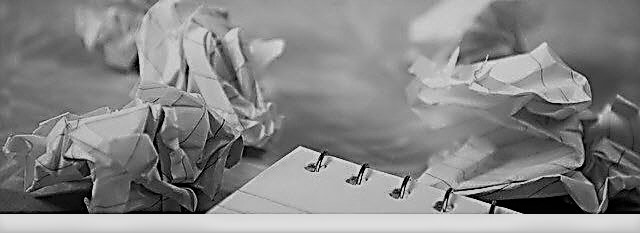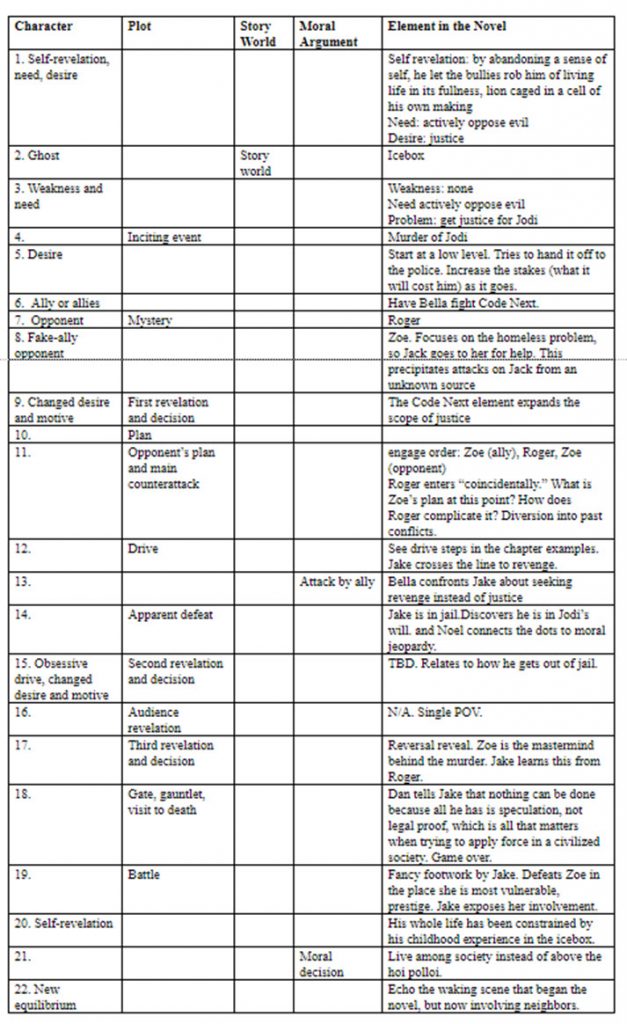Just a quick reminder that this behind-the-scene series chronicles my pre-writing process as I work through John Truby’s The Anatomy of Story to give aspiring writers a glimpse into the kind of work, and the depth and intensity of work, involved when developing an original story.
I am not suggesting that everyone must follow this process, merely that:
- Writing a novel is not a trivial task. It involves a significant amount of work.
- If you are daunted by the challenge of how to tackle such a large project, this is one example of many possible approaches to breaking the process down into manageable steps.
- If you are daunted by the size of the effort and doubt the value of the effort/reward trade off, you might want to consider something other than writing a novel.
Finally, these installments chronicle my notes and thought processes while working through Truby’s book. They will make more sense if you have a copy of the book for reference.
Chapter 5: Moral Argument
Single grand symbol: The arboreal resting places of Jack, above the messy life of humans, vs the urban jungle of the other main characters.
Moral decision: At first, Jack provides veiled hints to the police to let them deal with Jodi’s murder, but eventually realizes that if he doesn’t do something, nobody will. [I like this! Refusal of the call lite.] Show this struggle in an interaction with another character, perhaps Bella. Jack’s hands-off approach offends Bella’s micromanaging approach to “helping” others. Maybe her attempts to help put Jack in a bind and threaten his life. [Oooh, good idea!]
Truby: “A second way that moral argument comes out in dialogue is in a conflict between the hero and the opponent.” I’m picturing a bar scene between Jack and Roger where Jack drinks ginger ale or still water while Roger downs bourbon.
Designing principle -> theme: It is the duty of the strong to defend the defenseless. This is an argument against social Darwinism and against the non-dualistic views of Buddhism of a world of “what is, is,” of the non-distinction between good and evil. Story question: Why have you been given power if not to protect the powerless?
Jack takes it to the next level: In the first act, Jack moves from helping those in need to defending the victims from the victimizers. [This is good stuff.] Jack starts off as a kind of freelance social worker, but he doesn’t play an active role in confronting those preying on the helpless. Perhaps in the war he was a high-functioning conscientious objector. He takes a non-combat role to support people in the most need of support, those who are risking their lives. But he’s not going to kill anyone himself.
Theme line technique via symbol. The Randall knife = Excalibur. Use it as a symbol of honor, passing the torch to the next generation. It morphs to a symbol of dishonor when Riki loses it to Roger, who uses it for ill. In the climax scene, the knife “chooses” Jack and regains its honor.
Exercise 4
Transform the designing principle: David vs Goliath turns into defending the defenseless.
Theme line techniques: Symbol to encapsulate the designing principle. The Randall knife.
Moral choice: Step away from observer to participant
Central moral problem: Self preservation can lead to loss of self
Contextualized moral problem: it is the duty of the strong to defend the defenseless
Characters as variations on a theme
Starting with the hero and the opponent, describe how each major character approaches the central moral problem of the story in a different way.
Central moral problem: Self preservation can lead to loss of self
Jack (hero): Jack protects self by abandoning his sense of self. In Buddhist thought, suffering is a result of desire. You can reduce suffering by ridding yourself of desires. The more you diminish desire, the more you free yourself from the false sense of self, anatman (realization that there is no real self, sense of self is an illusion). The problem is that Jack’s search for peace through anatman is in conflict with his desire for revenge against his childhood tormentors. Perhaps the overstep is that he first seeks revenge before realizing that justice is better than revenge, the place of balance. Revenge is poison; justice is healing.
Roger (high functioning grifter): Roger focuses on self, wealth. If you were to ask him, Roger might answer that he is in no danger of losing himself because he places his welfare at the highest priority, but he lacks that level of introspection. The truth is that Roger doesn’t know his true self because he has never dug deeper than his animal desires. He has no more sense of self than has a wolf.
Zoe (councilperson): Zoe focuses on self by seeking prestige. Zoe fights insecurity born of self-consciousness by being assertive. She hides in plain sight by becoming the most visible person in the room. She seeks prestige to prove she deserves attention because of her accomplishments, not because she is pathetic, as she suspects is true.
Dan (judge): Dan asserts self to enforce the rule of law. Dan doesn’t make mistakes. Back in the 70s he thought he had made a mistake, but he was wrong about that, so his record remains unblemished. Fortunately for us lesser creatures, Dan is highly capable and uses his inborn self-confidence to impose order upon chaos by enforcing the law fairly.
Bella (high school friend): Bella asserts self to invest in community. Although they have never met, Bella is the spiritual heir of Dan, albeit with a greatly reduced scope of operation. She is equally self-assured of her perception, judgment, and advice.
Jodi (high school friend, deceased): Jodi denies self in service of others. Jodi is 9 minutes older than her twin brother, Riki. When their mother dies 9 years later, Jodi assumes the mantle of matriarch, carrying the burden of responsibility not only for her brother, but also for her father, who focuses on work to avoid straying beyond the first Kubler-Ross stage of grief, denial. Occasionally he slips into anger, but always reverts back to denial instead of moving forward. When she is unable to save her brother, Jodi follows her father’s example and buries herself in her career as executive assistant to the CEO of whatever company is behind the whole plot of this monstrosity.
Riki (high school friend, deceased): Riki indulges self. He is his mother’s son. Narcissistic, interpreting everything through the lens of his perception. Others exist only insofar as they impinge on his sense of self, how they enable or thwart his desires.
Noel (detective): Noel immerses self in solving the problem. If she had the bent, Noel would be a world champion at Scrabble or jigsaw puzzles, but these pursuits are too trivial. Her hyper-developed sense of justice bugs her like a painting crooked on the wall or a misaligned fork in the silverware drawer. Her laser focus and lack of flexibility or compromise make her an unstoppable force, but alienates her more balanced colleagues and guarantees her lack of advancement in her career. She is alternatively fine with this and outraged by the lack of fairness in office politics.
Values in conflict: outlined per character
Jack: Values peace, inner and outer. Jack’s journey toward oneness is born of a childhood trauma, but Jodi’s murder reawakens the injustice of his origin story. The further he falls into the rabbit hole of tracking down the killer, the more the two poles of detachment and revenge will conflict.
Roger: Values survival = financial success. Roger has become a past master of working the system of the underworld to leverage his gains and avoid losses. But he has never encountered a foe like Jack, and the more he tries to game the machine, the more he gets caught in the gears.
Zoe: Values respect. Like Roger, Zoe lives in a world of connections, concessions, and back-scratching symbiosis. By unintentionally pricking the attention of Jack, and to a lesser extent Dan and Noel, she runs into a brick wall of uncompromising opponents who are not susceptible to bribes or blackmail, none of whom are impressed with her “accomplishments” or power.
Dan: Values stability. Dan’s world is self-sustainable. He has no vulnerability for any of the players to exploit. And he gets a good night’s sleep every night.
Bella: Values harmony. Bella values harmony, but her autocratic manner creates conflict on its own, so she lives in a world of constant self-induced drama, which fuels her mothering instincts in a perpetual cycle.
Jodi: Values domestic tranquility. Dead, so no conflict in present story time. Will need to allow conflicts to emerge organically in backstory.
Riki: Values accomplishment. Dead, so no conflict in present story time. Will need to allow conflicts to emerge organically in backstory.
Noel: Values control. Noel’s singular focus and innate inflexibility manufactures conflict on an industrial scale in all areas of her life.


